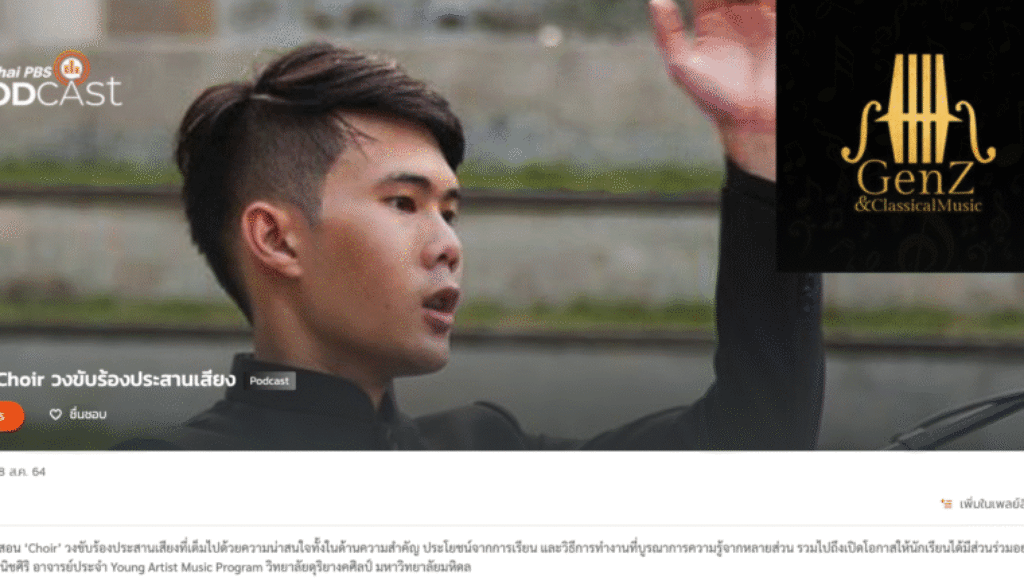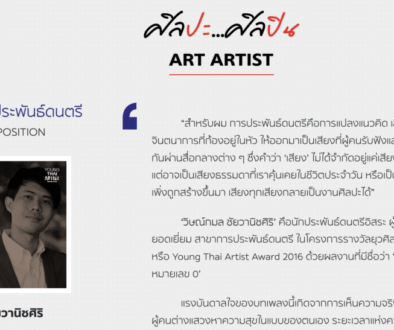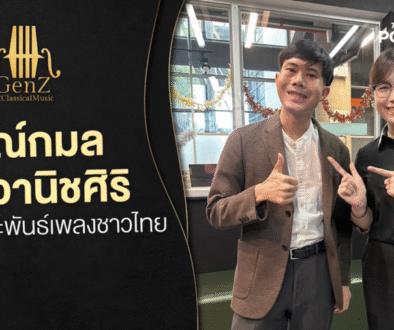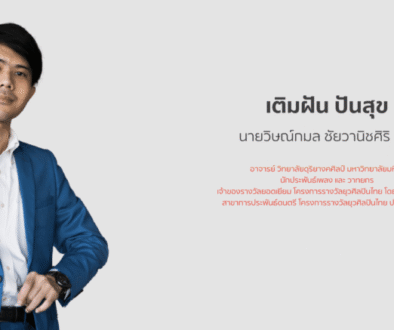Gen Z & Classical Music – EP. 126 – Choir วงขับร้องประสานเสียง
เผยแพร่ ณ https://www.thaipbspodcast.com/podcast/genzandclassicalmusic/126
วันที่เผยแพร่ : 28 ส.ค. 64
ถอดความ และ สรุปเนื้อหาโดย Google Gemini Pro 2.5
ผู้ดำเนินรายการ: คุณมุก ณัฏฐา ควรขจร แขกรับเชิญ: คุณวิษณ์กมล ชัยวานิชศิริ (อาจารย์โก้) อาจารย์และผู้ควบคุมวงขับร้องประสานเสียง YAMP Choir (Young Artist Music Program) วิทยาลัยดุริยางคศิลป์ มหาวิทยาลัยมหิดล
ช่วงที่ 1: บทนำและทำความรู้จักวงขับร้องประสานเสียง
รายการเริ่มต้นด้วยการเปิดประเด็นคำถามว่า “เรียนวงขับร้องประสานเสียงไปทำไม และต้องเรียนอะไรบ้าง?” จากนั้นจึงเปิดบทเพลงขับร้องประสานเสียงให้ผู้ฟังได้รับฟัง
- บทเพลงเปิดรายการ: คือเพลง “Deep River” ซึ่งเป็นเพลงสวดแนวสปิริชวล (Spiritual) ของคนผิวสีที่ถ่ายทอดเรื่องราวและความเชื่อทางศาสนา อาจารย์โก้อธิบายว่าเวอร์ชันที่ได้ฟังนั้นเรียบเรียงโดย Mark Hayes และเป็นการแสดงสดของ วง YAMP Choir (Young Artist Music Program) จากวิทยาลัยดุริยางคศิลป์ มหาวิทยาลัยมหิดล ซึ่งท่านเป็นผู้ควบคุมวงเอง
- ทำความรู้จักแขกรับเชิญ: อาจารย์โก้เล่าถึงเส้นทางดนตรีของตนเองว่าไม่ได้เริ่มต้นจากการร้องเพลง แต่เริ่มจากการเรียนเปียโน, จากนั้นจึงเข้าร่วมวงโยธวาธิตในโรงเรียนมัธยมศึกษา (โรงเรียนอุดมศึกษา) โดยเริ่มจากการเล่นคีย์บอร์ดในวงประกวด และด้วยความประทับใจในบรรยากาศการเล่นดนตรีร่วมกันจึงสมัครเข้าวงถาวรโดยเลือกเล่นแซกโซโฟนจนจบชั้น ม.6
- ในระดับปริญญาตรี ท่านเลือกเรียน สาขาการประพันธ์เพลง (Composition)
- ในระดับปริญญาโท ท่านเรียน สาขาการอำนวยเพลง (Conducting) และได้มีโอกาสทำงานกับวงหลากหลายรูปแบบทั้งวงเครื่องลมและวงออร์เคสตรา
- ท่านเพิ่งจะเข้ามาคลุกคลีกับวงการวงขับร้องประสานเสียงอย่างจริงจังในช่วง 2-3 ปีที่ผ่านมานี้เอง
ช่วงที่ 2: การเรียนการสอนในวงขับร้องประสานเสียง
- วงขับร้องประสานเสียงคืออะไร?: อาจารย์โก้ให้นิยามว่าคือ “วงที่ใช้การขับร้องในการสร้างสรรค์ดนตรี” โดยมีสมาชิกหลายคนที่มีช่วงเสียง (Vocal Range) แตกต่างกันมาขับร้องประสานกัน ทำให้เกิดความกลมกลืนของเสียงสูง-ต่ำ เช่น เสียงโซปราโน, อัลโต, เทเนอร์ และเบส
- ทักษะที่ต้องเรียนรู้:
- พื้นฐานการขับร้อง (Singing Technique): การหายใจที่ถูกต้อง, การวางท่าทาง (Posture), การเปล่งเสียง, การใช้รูปปากและอักขระวิธี เพื่อให้เสียงที่ออกมามีคุณภาพและเป็นไปในทิศทางเดียวกันทั้งวง
- ทักษะทางดนตรี (Musicianship): การอ่านโน้ตและจังหวะให้ถูกต้องแม่นยำ (Sight-reading)
- ทักษะการทำงานร่วมกัน (Ensemble Skill): ถือเป็นหัวใจสำคัญ คือ “การฟัง” นักร้องต้องฟังเสียงของตนเองให้เข้ากับเสียงของเพื่อนร่วมวงและเสียงโดยรวม เพื่อสร้างดนตรีที่มีเอกภาพ
- ทำไมจึงเป็นวิชาบังคับ?: ที่ YAMP วงขับร้องประสานเสียงเป็นหนึ่งในวิชา “การรวมวงใหญ่” (Large Ensemble) ที่นักเรียนดนตรีทุกคนต้องเรียน เหตุผลคือ:
- เป็นพื้นที่สำหรับนักเรียนที่เครื่องดนตรีหลักไม่สามารถรวมกับวงออร์เคสตราหรือวงเครื่องลมได้ เช่น นักเรียนเอกเปียโน, กีตาร์ หรือขับร้องโดยตรง
- เพื่อให้นักเรียนทุกคนได้ฝึกฝนทักษะการเล่นดนตรีร่วมกับผู้อื่นในวงขนาดใหญ่
- ทักษะที่ได้จากการเรียน โดยเฉพาะ การฟัง และ การตีความบทเพลง สามารถนำไปปรับใช้กับการเล่นเครื่องดนตรีหลักของตนเองได้เป็นอย่างดี
ช่วงที่ 3: ความท้าทายและปรัชญาการสอนของอาจารย์โก้
- การปรับตัวของผู้สอน: อาจารย์โก้ยอมรับว่าเนื่องจากพื้นฐานของท่านมาจากวงโยธวาธิต การมาควบคุมวงขับร้องประสานเสียงจึงต้องปรับตัวอย่างมาก ทั้งในเรื่องการเลือกบทเพลง และท่าทางการควบคุมวงที่ต้องละเอียดอ่อนกว่าเดิม ท่านต้องศึกษาหาความรู้เพิ่มเติมจากอาจารย์ผู้เชี่ยวชาญ (อ.เต้ ดร. ภาวศุทธิ์ พิริยะพงษ์รัตน์) และเรียนการร้องเพลงพื้นฐานจากพี่สาวของท่านเองในช่วงโควิด
- การสร้างแรงจูงใจในวิชาบังคับ: เพื่อแก้ปัญหาที่นักเรียนอาจไม่ชอบการเรียนวิชาบังคับ อาจารย์โก้ได้เปลี่ยนรูปแบบการสอนจากการสั่งการ (Top-down) มาเป็นการทำงานร่วมกัน (Collaboration)
- สร้างบรรยากาศ “การร่วมกันสร้างดนตรี”: เปิดโอกาสให้นักเรียนเสนอความคิดเห็นและมีส่วนร่วมในการตัดสินใจ
- Student Leadership: ให้นักเรียนที่มีความสามารถเฉพาะทางได้แสดงบทบาทผู้นำ เช่น ให้นักเรียนเอกขับร้องช่วยนำวอร์มเสียง หรือให้นักเรียนเอกประพันธ์เพลงช่วยเรียบเรียงเสียงประสานให้วง
- Student Selection: ในคอนเสิร์ตแต่ละครั้ง จะแบ่งเพลงครึ่งหนึ่งให้นักเรียนเป็นผู้เลือกเอง (ภายใต้ธีมที่กำหนด) เพื่อให้พวกเขารู้สึกเป็นเจ้าของผลงาน
- การจัดการเรียนการสอนออนไลน์:
- อุปสรรค: ไม่สามารถร้องเพลงพร้อมกันแบบเรียลไทม์ได้ เพราะสัญญาณเสียงจะดีเลย์
- การแก้ปัญหา: ใช้วิธีการซ้อมแยกส่วน โดยอาจารย์จะส่งแนวเสียงของแต่ละพาร์ทไปให้นักเรียนซ้อมเองที่บ้าน แล้วจึงอัดเสียงกลับมา นอกจากนี้ยังมีการใช้เทคโนโลยีเข้ามาช่วย เช่น Google Classroom สำหรับส่งงาน, LINE Group และ Discord ซึ่งเป็นแพลตฟอร์มที่นักเรียนเสนอและช่วยกันตั้งค่าห้องซ้อมย่อยสำหรับแต่ละแนวเสียง
- เรื่องเล่าประทับใจ: อาจารย์โก้เล่าถึงความรับผิดชอบของนักเรียนที่น่าประทับใจ เมื่อท่านติดภารกิจซ้อมรับปริญญา ไม่สามารถมาคุมซ้อมใหญ่ก่อนคอนเสิร์ตได้ นักเรียนซึ่งเป็นกลุ่มหัวหน้าของแต่ละแนวเสียงได้จัดการนัดซ้อมและดูแลการซ้อมใหญ่ทั้งหมดด้วยตนเองอย่างเป็นระบบโดยที่ท่านไม่ได้สั่งการไว้ล่วงหน้าเลย
ช่วงที่ 4: ผลงานอื่นๆ และบทเพลงส่งท้าย
- ผลงานด้านการประพันธ์และรายการออนไลน์: นอกจากงานสอนแล้ว อาจารย์โก้ยังเป็นนักประพันธ์เพลง และได้จัดทำรายการไลฟ์ชื่อ “Compose with Me” เพื่อเป็นพื้นที่ในการนำเสนอผลงานและพูดคุยกับนักประพันธ์เพลงชาวไทยรุ่นใหม่ท่านอื่นๆ สามารถติดตามผลงานได้ทาง Facebook Page และ YouTube Channel “ViskamolMusic” และเว็บไซต์ https://viskamol.com
- เรื่องเล่าขำขันของนักดนตรี: อาจารย์โก้เล่าประสบการณ์สมัยเรียนปี 1 ขณะกำลังจะขึ้นอำนวยเพลงในพิธีของคณะ ท่านรู้สึกเย็นๆ ที่กางเกงจึงก้มลงดูและพบว่า “ซิปกางเกงแตก” จึงต้องรีบสะกิดเพื่อนที่นั่งข้างๆ ให้ลุกไปเข้าห้องน้ำเพื่อ “สลับกางเกงกัน” ทำให้รอดพ้นจาก “Grand Opening” บนเวทีไปได้อย่างหวุดหวิด
- บทเพลงส่งท้าย: คือเพลง “Nyon Nyon” ประพันธ์โดย Jake Runestad เป็นเพลงที่นำสไตล์ดนตรีอิเล็กทรอนิกส์แดนซ์ (EDM) มาสร้างสรรค์ใหม่โดยใช้ “เสียงมนุษย์” ทั้งหมด ไม่ว่าจะเป็นการร้อง, การทำเสียงบีตบ็อกซ์ (Beatbox) และเสียงประกอบอื่นๆ ซึ่งแสดงให้เห็นถึงศักยภาพที่ไร้ขีดจำกัดของวงขับร้องประสานเสียง
ช่องทางการติดตามผลงานของวง: Facebook Page “YAMP Choir”
English Translation
Translated by Google Gemini 2.5 Pro on October 19, 2025
Published at: https://www.thaipbspodcast.com/podcast/genzandclassicalmusic/126
Publication Date: August 28, 2021 Transcribed and Summarized by: Google Gemini Pro 2.5
Host: Mook Nuttha Kuankajorn Guest: Viskamol Chaiwanichsiri (Ajarn Khoe), Lecturer and Conductor of the YAMP Choir (Young Artist Music Program), College of Music, Mahidol University.
Part 1: Introduction and Getting to Know the Choir
The program begins by posing the questions, “Why study in a choir, and what do you have to learn?” It then plays a choral piece for the audience.
- Opening Music: The song “Deep River,” a spiritual that conveys the stories and religious beliefs of African Americans. Ajarn Khoe explains that the version heard is arranged by Mark Hayes and is a live performance by the YAMP Choir (Young Artist Music Program) from the College of Music, Mahidol University, which he himself conducts.
- Getting to Know the Guest: Ajarn Khoe recounts his musical journey, which did not begin with singing. He started with piano lessons, then joined the marching band in secondary school (Udomsuksa School), beginning with the keyboard in the competition band. Impressed by the atmosphere of making music together, he joined the band permanently, choosing to play the saxophone until he graduated. For his bachelor’s degree, he majored in Composition. For his master’s degree, he majored in Conducting and had the opportunity to work with various ensembles, including wind bands and orchestras. He has only been seriously involved in the choral scene for the past 2-3 years.
Part 2: Learning and Teaching in a Choir
- What is a choir?: Ajarn Khoe defines it as “an ensemble that uses singing to create music,” where many members with different vocal ranges sing in harmony, creating a blend of high and low sounds, such as soprano, alto, tenor, and bass.
- Skills to be Learned:
- Singing Technique: Proper breathing, posture, vocal production, and the use of mouth shapes and articulation to ensure the sound produced is of high quality and uniform throughout the ensemble.
- Musicianship: The ability to accurately read notes and rhythms (sight-reading).
- Ensemble Skill: Considered the heart of choral singing, this is the skill of “listening.” Singers must listen to their own voice to blend with their fellow members and the overall sound, creating a unified musical performance.
- Why is it a compulsory subject?: At YAMP, choir is one of the “Large Ensemble” courses that all music students must take. The reasons are:
- It provides a space for students whose primary instruments cannot be integrated into an orchestra or wind band, such as piano, guitar, or vocal majors.
- It allows all students to practice the skill of making music with others in a large ensemble setting.
- The skills learned, especially listening and musical interpretation, can be readily applied to the playing of their primary instruments.
Part 3: Ajarn Ko’s Challenges and Teaching Philosophy
- Adaptation for the Instructor: Ajarn Khoe admits that because his background is in marching bands, conducting a choir required significant adaptation, both in repertoire selection and in conducting gestures, which need to be more delicate. He had to seek further knowledge from an expert (Ajarn Tae, Dr. Pawasut Piriyapongrat) and learn basic singing from his own sister during the COVID-19 pandemic.
- Creating Motivation in a Compulsory Subject: To solve the problem of students potentially disliking a required course, Ajarn Khoe shifted his teaching style from a top-down approach to one of collaboration.
- Creating an atmosphere of “co-creating music”: He provides opportunities for students to offer ideas and participate in decision-making.
- Student Leadership: He allows students with specific talents to take on leadership roles, such as having vocal majors lead warm-ups or having composition majors help with choral arrangements for the ensemble.
- Student Selection: For each concert, half of the songs are chosen by the students themselves (within a given theme) to give them a sense of ownership over the performance.
- Managing Online Teaching:
- Obstacle: Unable to sing together in real-time due to audio latency.
- Solution: He used sectional rehearsals. He would send the audio tracks for each part to the students to practice at home, and they would then record and send their parts back. Technology was also used to assist, such as Google Classroom for submitting assignments, LINE Group, and Discord—a platform that students suggested and helped set up for breakout rehearsal rooms for each vocal section.
- An Inspiring Story: Ajarn Khoe shared an impressive story about his students’ sense of responsibility. When he had a graduation rehearsal and could not lead the final rehearsal before a concert, the student section leaders organized and ran the entire rehearsal themselves systematically, without any prior instruction from him.
Part 4: Other Works and Closing Song
- Composition Works and Online Show: In addition to teaching, Ajarn Khoe is a composer and has created a live stream series called “Compose with Me” as a platform to present his work and converse with other new-generation Thai composers. His work can be followed on his Facebook Page and YouTube Channel “ViskamolMusic” and the website https://viskamol.com.
- A Musician’s Humorous Anecdote: Ajarn Khoe shared an experience from his first year of university. As he was about to go on stage to conduct at a faculty ceremony, he felt a draft and looked down to find his “pants zipper was broken.” He had to quickly nudge the friend next to him to go to the restroom to “swap pants,” narrowly avoiding a “Grand Opening” on stage.
- Closing Song: The song “Nyon Nyon” composed by Jake Runestad. It’s a piece that takes the style of electronic dance music (EDM) and creatively reconstructs it using only the “human voice” for everything, including singing, beatboxing, and other sound effects, showcasing the limitless potential of a choir.
- Where to follow the choir’s work: Facebook Page “YAMP Choir”



